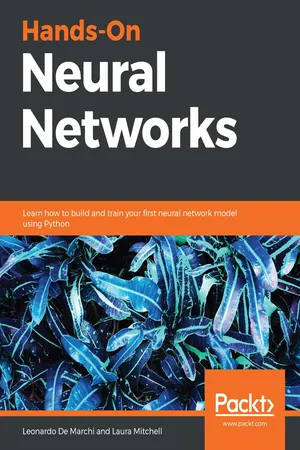
Hands-On Neural Networks
Learn how to build and train your first neural network model using Python
Leonardo De Marchi, Laura Mitchell
- 280 Seiten
- English
- ePUB (handyfreundlich)
- Über iOS und Android verfügbar
Hands-On Neural Networks
Learn how to build and train your first neural network model using Python
Leonardo De Marchi, Laura Mitchell
Über dieses Buch
Design and create neural networks with deep learning and artificial intelligence principles using OpenAI Gym, TensorFlow, and Keras
Key Features
- Explore neural network architecture and understand how it functions
- Learn algorithms to solve common problems using back propagation and perceptrons
- Understand how to apply neural networks to applications with the help of useful illustrations
Book Description
Neural networks play a very important role in deep learning and artificial intelligence (AI), with applications in a wide variety of domains, right from medical diagnosis, to financial forecasting, and even machine diagnostics.
Hands-On Neural Networks is designed to guide you through learning about neural networks in a practical way. The book will get you started by giving you a brief introduction to perceptron networks. You will then gain insights into machine learning and also understand what the future of AI could look like. Next, you will study how embeddings can be used to process textual data and the role of long short-term memory networks (LSTMs) in helping you solve common natural language processing (NLP) problems. The later chapters will demonstrate how you can implement advanced concepts including transfer learning, generative adversarial networks (GANs), autoencoders, and reinforcement learning. Finally, you can look forward to further content on the latest advancements in the field of neural networks.
By the end of this book, you will have the skills you need to build, train, and optimize your own neural network model that can be used to provide predictable solutions.
What you will learn
- Learn how to train a network by using backpropagation
- Discover how to load and transform images for use in neural networks
- Study how neural networks can be applied to a varied set of applications
- Solve common challenges faced in neural network development
- Understand the transfer learning concept to solve tasks using Keras and Visual Geometry Group (VGG) network
- Get up to speed with advanced and complex deep learning concepts like LSTMs and NLP
- Explore innovative algorithms like GANs and deep reinforcement learning
Who this book is for
If you are interested in artificial intelligence and deep learning and want to further your skills, then this intermediate-level book is for you. Some knowledge of statistics will help you get the most out of this book.
Häufig gestellte Fragen
Information
Section 1: Getting Started
- Chapter 1, Getting Started with Supervised Learning
- Chapter 2, Neural Network Fundamentals
Getting Started with Supervised Learning
- History of AI
- An overview of machine learning
- Environment setup
- Supervised learning in practice with Python
- Feature engineering
- Supervised learning algorithms
History of AI
An overview of machine learning
- Supervised learning
- Unsupervised learning
- Semi-supervised learning
- Reinforcement learning
Supervised learning
